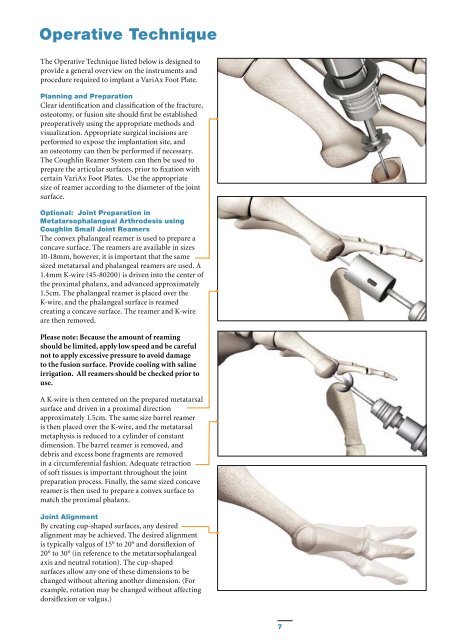Variax foot locking plate system - Stryker
Variax foot locking plate system - Stryker
Variax foot locking plate system - Stryker
You also want an ePaper? Increase the reach of your titles
YUMPU automatically turns print PDFs into web optimized ePapers that Google loves.
Operative Technique<br />
The Operative Technique listed below is designed to<br />
provide a general overview on the instruments and<br />
procedure required to implant a VariAx Foot Plate.<br />
Planning and Preparation<br />
Clear identification and classification of the fracture,<br />
osteotomy, or fusion site should first be established<br />
preoperatively using the appropriate methods and<br />
visualization. Appropriate surgical incisions are<br />
performed to expose the implantation site, and<br />
an osteotomy can then be performed if necessary.<br />
The Coughlin Reamer System can then be used to<br />
prepare the articular surfaces, prior to fixation with<br />
certain VariAx Foot Plates. Use the appropriate<br />
size of reamer according to the diameter of the joint<br />
surface.<br />
Optional: Joint Preparation in<br />
Metatarsophalangeal Arthrodesis using<br />
Coughlin Small Joint Reamers<br />
The convex phalangeal reamer is used to prepare a<br />
concave surface. The reamers are available in sizes<br />
10-18mm, however, it is important that the same<br />
sized metatarsal and phalangeal reamers are used. A<br />
1.4mm K-wire (45-80200) is driven into the center of<br />
the proximal phalanx, and advanced approximately<br />
1.5cm. The phalangeal reamer is placed over the<br />
K-wire, and the phalangeal surface is reamed<br />
creating a concave surface. The reamer and K-wire<br />
are then removed.<br />
Please note: Because the amount of reaming<br />
should be limited, apply low speed and be careful<br />
not to apply excessive pressure to avoid damage<br />
to the fusion surface. Provide cooling with saline<br />
irrigation. All reamers should be checked prior to<br />
use.<br />
A K-wire is then centered on the prepared metatarsal<br />
surface and driven in a proximal direction<br />
approximately 1.5cm. The same size barrel reamer<br />
is then placed over the K-wire, and the metatarsal<br />
metaphysis is reduced to a cylinder of constant<br />
dimension. The barrel reamer is removed, and<br />
debris and excess bone fragments are removed<br />
in a circumferential fashion. Adequate retraction<br />
of soft tissues is important throughout the joint<br />
preparation process. Finally, the same sized concave<br />
reamer is then used to prepare a convex surface to<br />
match the proximal phalanx.<br />
Joint Alignment<br />
By creating cup-shaped surfaces, any desired<br />
alignment may be achieved. The desired alignment<br />
is typically valgus of 15° to 20° and dorsiflexion of<br />
20° to 30° (in reference to the metatarsophalangeal<br />
axis and neutral rotation). The cup-shaped<br />
surfaces allow any one of these dimensions to be<br />
changed without altering another dimension. (For<br />
example, rotation may be changed without affecting<br />
dorsiflexion or valgus.)<br />
7
















